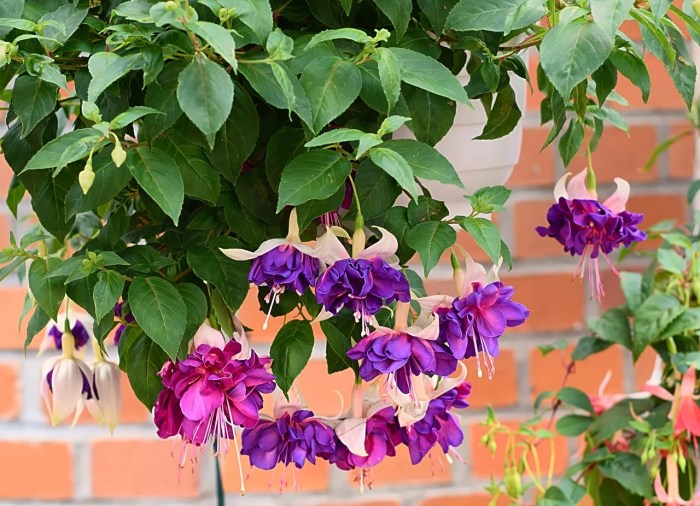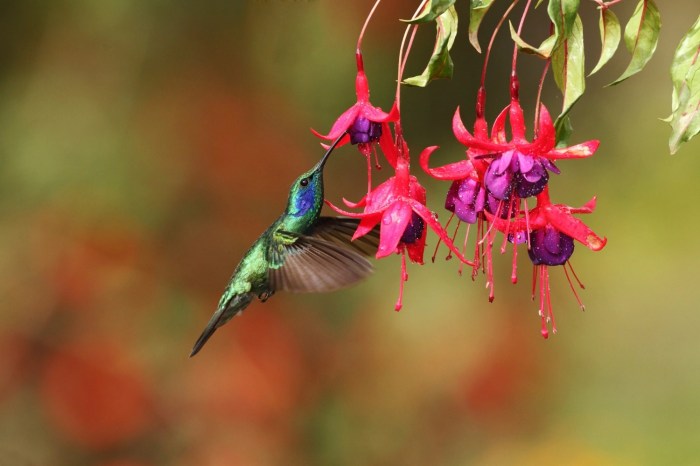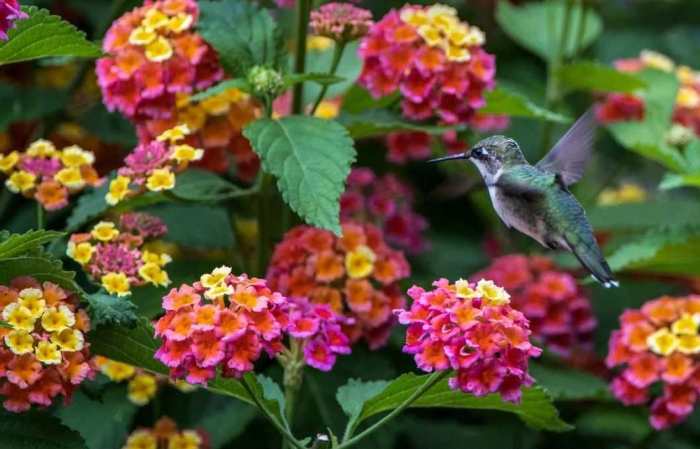10 hanging plants good for hummingbirds and butterflies are a beautiful and easy way to attract these delightful creatures to your garden. These plants offer a variety of colors, shapes, and sizes, so you can find the perfect ones to complement your outdoor space.
They are also relatively easy to care for, making them a great choice for gardeners of all levels.
Here are 10 of the best hanging plants for hummingbirds and butterflies:
Fuchsia

Fuchsia is a genus of flowering plants with beautiful, dangling blooms that come in various colors and shapes. They are popular among gardeners for their adaptability and attractiveness to hummingbirds and butterflies.
Fuchsia plants can grow as shrubs, climbers, or even small trees. Their foliage is typically dark green and glossy, providing a striking contrast to their vibrant flowers. Fuchsia blooms consist of four sepals and four petals, with the sepals often being a different color than the petals.
The flowers are rich in nectar, making them a favorite food source for hummingbirds and butterflies.
For nature enthusiasts seeking to attract hummingbirds and butterflies to their outdoor spaces, hanging plants offer an ideal solution. From vibrant lantana to delicate fuchsia, these 10 hanging plants provide a feast for these winged visitors. If you’re looking to enhance your vertical gardening with these charming plants, check out Hanging Plants from Wall: A Guide to Vertical Gardening for expert tips on creating a lush, eye-catching display.
Continue experimenting with these hanging plants to create a welcoming haven for hummingbirds and butterflies.
Attracting Hummingbirds and Butterflies
To attract hummingbirds and butterflies to your garden, plant Fuchsia in a sunny or partially shaded area with well-drained soil. Choose varieties with brightly colored flowers and a long blooming period. Consider planting Fuchsia in hanging baskets or containers to make them more accessible to these pollinators.
Growing Conditions and Care
Fuchsia plants prefer moist, well-drained soil with a pH of 6.0 to 6.5. They require regular watering, especially during hot and dry weather. Fertilize Fuchsia plants monthly with a balanced fertilizer. Prune them regularly to encourage bushy growth and flowering.
Fuchsia plants are relatively easy to care for and can add a touch of elegance and beauty to any garden. With their vibrant blooms and ability to attract hummingbirds and butterflies, they are a perfect choice for gardeners who want to create a pollinator-friendly landscape.
Lantana

Lantana is a vibrant and easy-to-grow flowering plant that is a favorite among hummingbirds and butterflies. Its clusters of small, colorful flowers come in a wide range of hues, including pink, orange, yellow, and purple. Lantana is a low-maintenance plant that is well-suited for hanging baskets and containers.
Attracting Hummingbirds and Butterflies
Lantana’s bright colors and sweet nectar are irresistible to hummingbirds. The flowers’ long, slender tubes are perfectly shaped for hummingbirds’ bills, allowing them to easily extract the nectar. Butterflies are also attracted to Lantana’s flowers, as they provide a good source of food and shelter.
Low-Maintenance Benefits, 10 hanging plants good for hummingbirds and butterflies
Lantana is a relatively low-maintenance plant that is easy to care for. It prefers full sun to partial shade and well-drained soil. Lantana is drought-tolerant and can withstand periods of neglect, making it a good choice for busy gardeners.
Petunia

Petunias are a popular choice for hanging baskets due to their vibrant colors and long blooming period. They come in a wide variety of colors, including white, pink, red, purple, and yellow. Petunias also have a variety of shapes, including single, double, and ruffled.
To create a hanging basket with petunias, start by filling the basket with a well-draining potting mix. Then, plant the petunias around the edge of the basket, spacing them about 6 inches apart. Water the plants well and fertilize them regularly.
Types of Petunia
There are many different types of petunias, but some of the most popular varieties for hummingbirds and butterflies include:
- Grandiflora petunias: These petunias have large, showy flowers that are up to 4 inches in diameter. They come in a wide range of colors, including white, pink, red, purple, and yellow.
- Multiflora petunias: These petunias have smaller flowers than grandiflora petunias, but they produce more flowers per plant. They are also available in a wide range of colors.
- Wave petunias: These petunias have a trailing habit, which makes them ideal for hanging baskets. They produce a profusion of small flowers in a variety of colors.
Mandevilla: 10 Hanging Plants Good For Hummingbirds And Butterflies
Mandevilla, also known as Chilean jasmine, is a popular choice for hanging baskets due to its showy flowers and long blooming period. The flowers, which resemble those of oleander, come in a range of colors including pink, red, white, and yellow.
These 10 hanging plants are a hummingbird and butterfly magnet, adding a touch of vibrant color to any garden. For more inspiration on vertical gardening and design, refer to Hanging Plants Garden: A Guide to Vertical Gardening and Design for comprehensive guidance on creating a stunning vertical oasis.
Continue exploring the benefits of these hanging plants, known for attracting these delightful pollinators.
They are typically trumpet-shaped with five petals and a prominent central stamen. Mandevilla is a vigorous grower and can quickly fill a hanging basket with its trailing stems.
For nature enthusiasts, adorning homes with hanging plants not only adds aesthetic value but also attracts wildlife. Among the top choices for attracting hummingbirds and butterflies are fuchsia, lantana, and geraniums. If you’re looking to expand your indoor plant collection, consider exploring the vast array of hanging plants indoor . By incorporating these vibrant species into your living space, you can create a harmonious haven for both flora and fauna, while adding a touch of natural beauty to your home.
Mandevilla is a tropical plant that prefers warm temperatures and bright light. It can be grown outdoors in USDA hardiness zones 9-11, but it is often grown as an annual in cooler climates. Mandevilla can be grown in a variety of soils, but it prefers a well-drained potting mix.
The plant should be watered regularly, but it should not be allowed to sit in water.
Optimal Growing Conditions
To ensure optimal growth and flowering, Mandevilla requires:
- Bright light:Mandevilla prefers full sun to partial shade, but it can tolerate low light conditions.
- Warm temperatures:Mandevilla prefers temperatures between 65 and 85 degrees Fahrenheit (18 to 29 degrees Celsius).
- Well-drained soil:Mandevilla prefers a well-drained potting mix that is rich in organic matter.
- Regular watering:Mandevilla should be watered regularly, but it should not be allowed to sit in water.
- Fertilization:Mandevilla should be fertilized monthly with a balanced fertilizer.
Pentas
Pentas, a vibrant genus of flowering plants, is renowned for its captivating star-shaped blooms and compact growth habit. These delightful plants add a touch of elegance to hanging baskets, attracting a wide range of pollinators, including hummingbirds and butterflies.
Whether you’re a seasoned gardener or just starting out, adding hanging plants to your outdoor space can provide a vibrant and inviting atmosphere. Ten hanging plants, such as the fuchsia and lantana, are particularly attractive to hummingbirds and butterflies. But did you know that hanging plants can also enhance the well-being of your feline friends? Check out Hanging Plants for Cats: Enhancing Feline Well-being to learn more about the benefits of hanging plants for cats.
And don’t forget to consider these ten hanging plants to attract hummingbirds and butterflies to your garden.
The star-shaped flowers of Pentas come in a kaleidoscope of colors, including pink, red, purple, and white. Their intricate petals and prominent stamens create a captivating display that is irresistible to pollinators. The compact growth habit of Pentas makes them ideal for hanging baskets, as they cascade gracefully over the edges, creating a mesmerizing floral waterfall.
Growing Pentas in Hanging Baskets
Growing Pentas in hanging baskets is a rewarding endeavor that requires minimal effort. Here are a few tips to ensure their success:
- Choose a well-draining potting mix:Pentas prefer well-drained soil that allows excess water to drain freely.
- Water regularly:Water Pentas regularly, especially during hot and dry weather. Allow the soil to dry out slightly between waterings.
- Fertilize monthly:Fertilize Pentas monthly with a balanced liquid fertilizer to promote healthy growth and abundant flowering.
- Provide plenty of sunlight:Pentas thrive in full sun to partial shade. Ensure they receive at least 6 hours of direct sunlight per day.
- Deadhead spent blooms:Deadheading spent blooms encourages new growth and prolongs the flowering period.
Conclusive Thoughts

With their vibrant colors and sweet nectar, these hanging plants are sure to attract hummingbirds and butterflies to your garden. So why not add a few to your outdoor space today?
FAQ Insights
What are the best hanging plants for hummingbirds?
Some of the best hanging plants for hummingbirds include fuchsia, lantana, petunia, mandevilla, and pentas.
What are the best hanging plants for butterflies?
Some of the best hanging plants for butterflies include lantana, petunia, pentas, and verbena.
How do I care for hanging plants?
Hanging plants need to be watered regularly, especially during hot weather. They also need to be fertilized every few weeks. Be sure to choose a hanging plant that is appropriate for your climate and growing conditions.